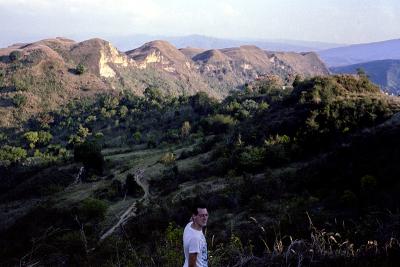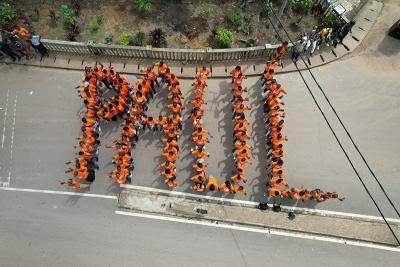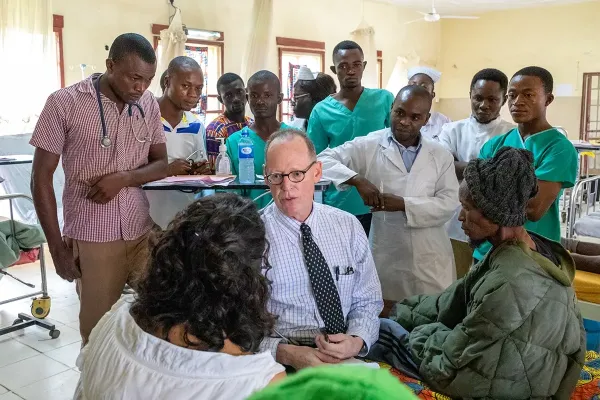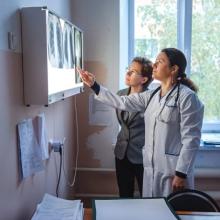Three decades ago, Partners In Health’s Co-founder Dr. Paul Farmer and global colleagues embarked on a journey to combat multidrug-resistant tuberculosis (MDR-TB) in low-resource settings, such as the rural Central Plateau in Haiti and densely populated neighbourhoods surrounding Lima, Peru.
Farmer championed a model of community-based TB treatments that kept patient concerns at the centre of care, forever transforming global health delivery, research, and policies. This approach addressed the underlying factors that contribute to disease spread, ensured marginalized populations received the medical support they deserved, and laid the foundation for sustainable solutions that have improved TB outcomes worldwide.
Although Farmer passed away in February 2022, his legacy remains strong. The work he started decades ago continues to bear fruit and inspires innovations that have revolutionized TB care. His example inspired new generations of TB experts to follow in his footsteps, at PIH and beyond.
The timeline below highlights Farmer’s pivotal role in the fight to end TB, driven by a vision for equitable health care that lives on today.
1989: Reimagining TB treatment in Haiti
Farmer and colleagues at Zanmi Lasante, as PIH is known in Haiti, established community-based tuberculosis treatment by ensuring patients received medications, food packages to improve nutrition, and a community health worker, who provided emotional support and resources along patients’ care journey.

PIH Archives
1991: Community-based care increases cure rates
Farmer conducted and reported the results of a first clinical trial in which a group of Haitian patients living with TB received community-based care and social support in rural areas. Compared to a group that received only free care, those receiving the full support package had substantially better treatment outcomes: no deaths and a 100% cure rate. The study revealed the benefits of accompaniment and helped establish PIH’s signature approach for managing complex diseases in impoverished settings.

PIH Archives.
1996: MDR-TB fight moves to Peru
Following visits to Peru, PIH Co-founder Dr. Jim Yong Kim helped uncover an MDR-TB outbreak among patients living on the outskirts of Lima. He, Farmer, and other Harvard colleagues found common cause with Peruvian clinicians and researchers and formed Socios En Salud, as PIH is known locally, to fight the disease.

PIH Archives
1998: New model improves MDR-TB patient outcomes
Farmer and Kim introduced the idea of DOTS-Plus (Directly Observed Therapy, Short-Course) to expand the WHO recommendation for treatment of TB beyond first-line therapies—and beyond just watching people take their medication—to include other drug regimens coupled with supportive care for MDR-TB patients. After successfully piloting a small community-based treatment program for patients living with MDR-TB in Lima, Peru, they argued that such programs could not only achieve excellent treatment outcomes but could be cost-effective if such interventions reduced disease and disability and prevented ongoing spread of MDR-TB.
PIH proved this model of MDR-TB care in Haiti and Peru and then expanded it to Russia—and beyond.

PIH Archives
2001: Global Fund to Fight AIDS, TB and Malaria is born
Farmer and PIH’s work in Haiti inspires pressure from the global access community, and he and others sign statements of support for global funding to treat infectious diseases. The United Nations General Assembly endorses the creation of a global fund to fight HIV/AIDS in June 2001, which holds its first meeting in January 2002. Since that time, the Global Fund to Fight AIDS, Tuberculosis and Malaria has provided 76% of all international financing for TB, investing $9.9 billion in TB programs and an additional $1.9 billion in TB/HIV programs.

Photo by Mark Rosenberg / Partners in Health Canada
2002: A worldwide initiative for AIDS and TB relief
Farmer is one of four doctors invited to the White House by Dr. Anthony Fauci, then the director of the National Institute of Allergy and Infectious Diseases, and presents PIH’s outcomes data from treating AIDS in rural Haiti with community health workers. PIH’s work is a key part of the evidence that convinces President George W. Bush to announce at the 2003 State of the Union address the President’s Emergency Plan for AIDS Relief, which has provided antiretroviral treatment for 20.5 million people and TB preventive therapy for 13.4 million people on ART. This was especially important funding in the fight against TB, given the disease was the most frequent infection among people living with HIV globally.

PIH Archives
2003: Evidence of success in MDR-TB treatment
A study published in the New England Journal of Medicine about the DOTS-Plus program in Peru demonstrated that 83% of properly treated and supported MDR-TB patients could experience good treatment outcomes; this countered the prior narrative that it was not possible (or worthwhile) to treat MDR-TB in poor settings. This study ignited WHO support for the uptake of DOTS-Plus and the adoption of global policies to directly address drug-resistant TB. The paper has been cited in medical literature over 500 times.
This same year, Farmer testified on Capitol Hill before the United States Senate Committee on Foreign Relations stressing the urgency of a growing health care crisis in Haiti. Increased TB deaths were due in part to U.S. policy affecting the country and the total amount of aid being reduced by two-thirds since 1995.

Photo by Ophelia Dahl / Partners In Health Canada
2005: Transforming WHO’s TB care guidelines
PIH’s model of care for MDR-TB and accompanying studies informed WHO’s 2005, 2008, and 2011 guidelines on the programmatic management of MDR-TB.
Farmer and Kim summarized PIH’s influence on international MDR-TB policy in a 2005 article, in which they were optimistic about the future of global health and challenged everyone to be more ambitious: “The world is now poised to move beyond minimalism and think about the full range of tools and interventions that will be necessary to meet the most pressing global health challenges.”

Photo by Justin Ide / Partners In Health Canada
2010: TB tied to global poverty
Through a publication in The Lancet, Farmer and fellow activists with Treatment Action Group, an independent and community-based research and policy think tank fighting to end HIV, TB, and hepatitis C virus, called for “a bold new vision at the Stop TB Partnership,” a UN organization established in 2001 to eliminate TB.
“Tuberculosis control and elimination need to be more closely aligned with the general economic development of afflicted communities. The natural history of tuberculosis clearly shows that to achieve tuberculosis elimination there needs to be some degree of poverty alleviation,” Farmer and authors wrote.

Dr. Farmer and Doctors Chiyembekezo Kachimanga and Noel Kalanga (left to right) discuss Rose Kaliwo, a patient later diagnosed with TB and HIV, during teaching rounds at Neno District Hospital in Malawi.
Photo by Rebecca Rollins / Partners In Health Canada
2013: Grassroots advocates fundraise for TB
Farmer helps launch the PIH Engage grassroots volunteer network, with hundreds of individuals fundraising in their communities for PIH’s TB work and advocating for billions of dollars in funding of multilateral and bilateral TB programs, such as the Global Fund.
With his encouragement and guidance, this network contributes annually to growing the global funding pie, through thousands of calls, letters, and meetings with policymakers. As a result of continued advocacy, bilateral TB funding grew from less than $100 million in 2006 to $233 million in 2013.

Dr. Farmer speaks with participants of the PIH Engage Training Institute in Boston, Massachusetts.
Photo by Sheena Wood / Partners In Health Canada
2015: Launching the endTB project
PIH, Médecins Sans Frontières, and Interactive Research and Development launched the endTB project, which aimed to find shorter, less toxic, and more effective treatments for MDR-TB through access to new drugs (delamanid and bedaquiline), clinical trials, and advocacy at national and global levels.
Farmer’s influence was intentionally woven into every aspect of endTB: through the accompaniment of national TB programs as they introduced new drugs into care regimens, advocating for lower drug prices, ensuring patients benefitted from advancements in research and quality care, and supporting patients beyond medical treatment to address other needs, such as food, housing, and financial assistance.

Visiting Port Loko Government Hospital in Sierra Leone, Dr. Farmer reviews a sample of cells from the lungs of a 9-year-old patient living with TB.
Photo by Rebecca Rollins / Partners In Health Canada
2019: US congressional support for equity-driven TB solutions
Farmer and the PIH Advocacy team are tapped by US congressional leaders to integrate equity-focused TB elimination strategies into annual U.S. funding of TB programs. He and his PIH colleagues also provide technical advice to Congress on the TB reauthorization strategy bill, the End TB Now Act.

Dr. Farmer consults with Dr. Marta Patiño about a 22-year-old patient suspected and later confirmed to have TB in the men’s ward at KGH in Sierra Leone.
Photo by John Ra / Partners In Health Canada
February 21, 2022
Farmer passed away in Rwanda, but the work he inspired continued.

PIH Sierra Leone staff recognize the first Global Day of Action outside the Maternal Center of Excellence in Kono District.
Photo by Tappiah Sesay / Partners In Health Canada
2023: New MDR-TB regimens revealed
In November, endTB clinical trial results were presented for the first time at the Union World Conference on Lung Health with evidence to support the use of three new, improved regimens to treat forms of TB that are resistant to rifampin, the most important drug in standard TB treatment.
2024: WHO approves three, new MDR-TB regimens
In August, the WHO approved new, safe, and effective tuberculosis treatment options, including three new shorter regimens for multidrug- or rifampin-resistant tuberculosis, which were studied in the PIH-led endTB clinical trial.
The resulting recommendations, which for the first time offer novel, shortened regimens universally to children, adolescents, pregnant and breastfeeding women, represent the culmination of nearly a decade of scientific research and patient care across 18 countries.

Janki Moneni, a 61-year-old MDR-TB patient, receives care in an ICU at Botšabelo Hospital in Maseru, Lesotho.
Photo by Justice Kalebe / Partners In Health Canada
Help Deliver the Cure
With your support, we can take critical steps toward ending tuberculosis worldwide. Your gift will help bring life-saving treatments to communities most in need and support innovative solutions in the fight against TB. Together, let’s make a lasting impact on global health.


